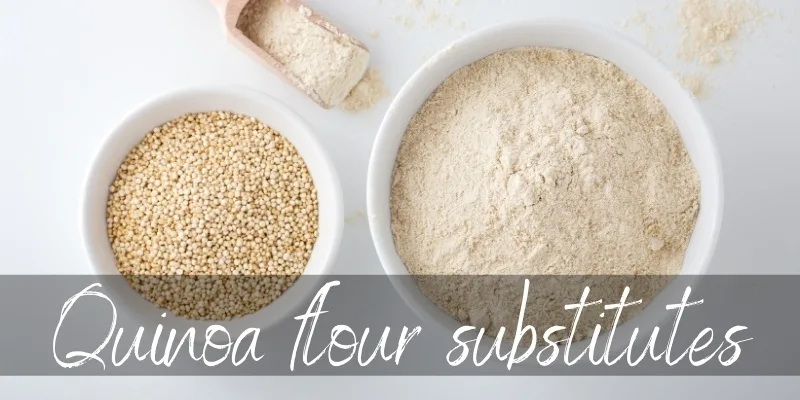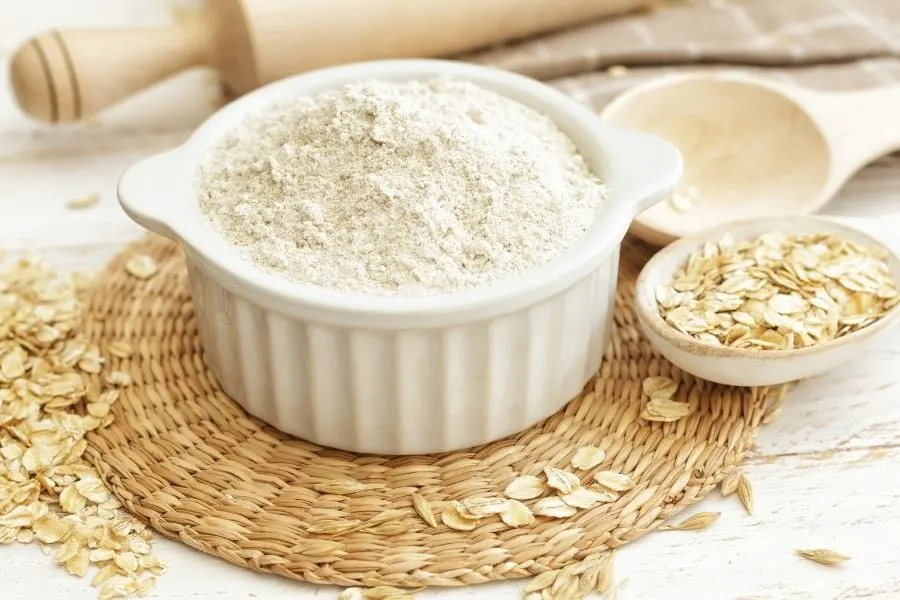Whether you have some white flour shortage or are simply working on some dietary restrictions, quinoa flour is a wonderful baking aid. If you can’t find it in your grocery store or don’t have time to prepare it at home, there’s some amazing flour alternatives out there.
Prepared using grains, seeds, and nuts, they’re going to come to the rescue. Below is a list of various quinoa flour substitutes that takes you through each option.

What’s the best quinoa flour substitute?
The best quinoa flour substitutes are brown rice flour, oat flour, almond flour, buckwheat flour, teff flour, coconut flour, chickpea flour and millet flour.
All of these are fairly easy to find, and are gluten free as well. As quinoa flour is expensive, some of these substitutes provide a more affordable option.
You can also make your own quinoa flour. All you need are quinoa grains (dry, raw). Toast them just a little in a dry skillet, allow to cool, then throw them in a spice grinder or blender. Blend for 1 minute until you get a very fine powder, the sieve the powder.
And there you go, quinoa flour ! Of course, it might still be expensive since you have to buy the quinoa. But still, it’s an option. Now let’s take a look at the other options and substitutes you have.
Brown rice flour
Quinoa flour is a wonderful alternative for those who are avoiding wheat or gluten-containing flours. You can get it at the store, or simply make the protein-rich flour at home by grinding raw quinoa seeds.
However, if you don’t have it on hand – you can substitute quinoa flour with brown rice flour. They both are medium flours, and brown rice flour matches quinoa flour very closely in terms of the binding behavior, the calorie counts and the fiber content.
For every 1 cup of quinoa flour used in a recipe, you can go for seven-eighth cup of brown rice flour to achieve the same results.
As stated above, this one is the closest quinoa flour substitute in terms of the texture, flavor, and preparation process. While quinoa is a seed, the flour’s making is only one stage of processing away from brown rice flour. Rice is a seed too, but it counts as a grain after the removal of its husk.
After the initial processing stage, you get brown rice, which further yields high-fiber brown rice flour with a light and powdery texture. It’s a wonderful choice of people who are new to the idea of using alternative or gluten-free flours. Perfect for making baked goods, it’s super easy to work with and comes with a well-balanced flavor at the same time.
Read Also:Best Gram Flour Substitutes
Oat flour
The surprising convenience associated with oat flour makes it one of the best flour substitutes out there. Just some grinding of the oats in the pantry, and you have some oat flour within minutes. The mild taste, the tender texture, and a great amount of proteins make oat flour super versatile. Go for some gluten-free oats and you can work up everything ranging from protein bars, cookies, pancakes and more!

Almond flour
Almond flour is prepared with blanched as well as unblanched almonds. While the former comes with a finely ground and light texture, the latter is worked up with almonds having their skin on, thereby has a slightly coarse texture.
You can whip it up easily at home, and would love to swap it with quinoa flour or white flour when making baked treats, specially brownies, cookies and more. It’s super versatile and works wonders when used to replace breadcrumbs.
Buckwheat flour
Prepared with groats, or buckwheat seeds – this flour is gluten-free and very tasty at the same time. It’s packed with a generous dose of protein and fiber, while featuring a really earthy, nutty flavor. You can always pair it with another flour of your choice, or simply make some classic buckwheat pancakes using it.
Teff flour
A staple grain grown in abundance in Ethiopia and Eritrea, teff is most commonly ground into flour and used to prepare a spongy sourdough flatbread called Injera. It’s wonderful to bring out an earthy flavor and a nutty touch to baked goods like muffins and quick breads.
Plus, it works just perfect when combined with other gluten-free flours. No matter what you use it for, this quinoa flour substitute is a very nutritious option rich in fiber and protein.
Coconut flour
Amazingly high in fiber, coconut flour is prepared when coconut pulp is dried out and ground up. However, make sure you don’t use it for one-to-one substitutions to prevent it from absorbing lots of moisture and ending up in a heavier texture. Instead, add more eggs or other wet ingredients to the same to get the best results.
Free of gluten, coconut flour works best for quick breads with many wet ingredients, like banana bread. The fact that it’s naturally grain-free makes it a great choice for people on grain-free diets.
Chickpea flour
Chickpea flour is worked up using dried and finely ground garbanzo beans. It’s very rich in protein and fiber and works as an awesome substitute. It not only holds together magically well, but also adds so much more texture to the treat.
It’s best to use for sweet and savory snacks like pancakes, crepes, socca, dumplings, and breads. It comes with an earthy taste and a nutty touch, while being versatile with a mild flavor. This gluten-free quinoa flour substitute is typically prepared using Bengal grams.
Read Also:Are Grains Vegetables ?
Millet flour
Millet flour is worked up from a small grain-like seed rich in fiber and protein and fiber. Speaking of the texture, it comes with a starchy, soft consistency and that’s what makes it a great choice for gluten-free treats like muffins, cookies, and chocolate cake. However, it’s often recommended to combine millet flour with at least one other flour to bring out a great flavor, specially when baking.

Each of the above flours and their uniqueness makes it interesting to use them, specially if you are new to baking with all those flavors. However, they are all slightly different, and you often can’t just swap them in with quinoa flour or all-purpose flour to get great results.
While some need more liquid, others may call for some sort of additions to the final recipe. Simply start by adding only small amounts of flour, until you get exactly what you are looking for. And yes, don’t hold back from experimenting!

